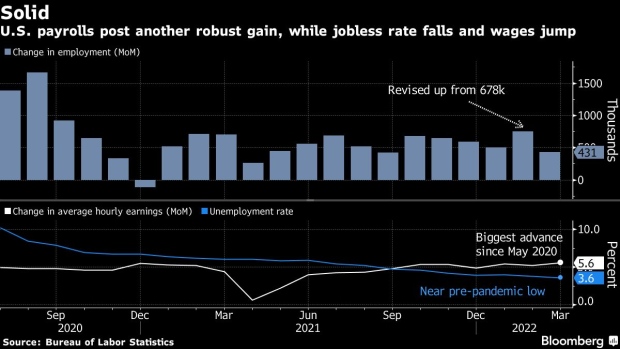Apr 21, 2022
Fed Risks Shattering Pro-Jobs Policy by Taking Hammer to Prices
, Bloomberg News

(Bloomberg) -- Jerome Powell wants to quell inflation without sinking the labor market. Success or failure will be a defining part of the Federal Reserve chair’s legacy and the pro-employment policy he’s championed.
“Can we cool down -- sort of -- labor demand without causing employment to fall?” Fed Governor Christopher Waller said on April 11. He sounded cautious, calling interest rate policy a “brute force” hammer that sometimes breaks things: “That’s the tricky road that we’re on.”
What happens to the U.S. job market, where unemployment currently stands at an ultra-low 3.6%, will rank alongside Powell’s widely-praised emergency pandemic response in dictating how history records his two terms at the helm of the world’s most powerful central bank.
Powell will have one of the final words on the imminent policy outlook before the U.S. central bank enters its usual pre-meeting blackout when he addresses an International Monetary Fund panel on Thursday. The Fed next meets May 3-4.
The careful response of the Fed to surging price pressures has been slammed by some for being too slow. But it was rooted in an approach the central bank called its new framework, adopted in August 2020 as the economy still grappled with Covid-19.
That policy explicitly repented from pre-emptive strikes on distant inflation threats that left workers -- often from minority communities -- mired in jobless recoveries by slowing the economy too soon.
The Fed carried the framework into the post-Covid expansion, pledging not to raise rates off zero until the labor market reached maximum employment. Both the jobs market and inflation overshot rates that the Fed estimates are sustainable.
Powell recently described the labor market as “tight to an unhealthy level,” citing more than 1.7 job openings for every unemployed person. Inflation measured by the Fed’s favored gauge rose 6.4% for the 12 months ending February, more than three times the Fed’s target of 2%.
If the framework delivers neither stable prices nor maximum employment -- no matter what shocks arise -- that raises questions about how much future support it will have and whether it needs to change.
“The framework didn’t look ahead to these circumstances. It encompasses risk management but only in a very limited sense,” said Derek Tang, an economist at LH Meyer, a policy-analysis firm in Washington. “I am not sure it is going to survive in its current form until the next review.”
Fed officials intend to undertake a public review of their strategy, tools, and communication practices roughly every five years.
Policymakers partially excuse their late start on the inflation fight, saying they have been faced with unexpected shocks, such as Russia’s invasion of Ukraine and another round of virus lockdowns in China.
Yet as former Fed Chair Alan Greenspan said in 2004, uncertainty is a “pervasive feature” of a globalized economy, requiring agile monetary policy. The new framework is built on the idea of prevailing low inflation.
“It is not the world we live in and may not be the world we are going back to,” said Matthew Luzzetti, chief U.S. economist at Deutsche Bank Securities, which is forecasting a recession that pushes the unemployment rate above 5% in 2024.
There is a lot for workers to like about how the job market galloped out of the pandemic downturn, even if opinion polls repeatedly show high prices are a pressing concern among Americans.
The U.S. added almost 1.7 million jobs in the first quarter versus 527,000 in the first three months of 2019.
The unemployment rate for people with high school diploma and no college education stood at 4% last month. The jobless rate for Hispanics was 4.2%, as low as it got in the final quarter of 2019, and for Black Americans it was 6.2% in March -- above the 2019 lows.
Workers in lower-wage jobs have bargaining power and some are unionizing. Women are also coming back to the labor force, after being pushed out during the pandemic by a lack of child care and in-classroom schooling.
Sue Bortone, a senior partner at the executive search firm Talentfoot, says it is a great time for them to jump back in. Companies are offering better benefits and more flexibility to keep valuable employees.
“There is so much opportunity,” said Bortone. “We don’t see it slowing down.”
Fed Governor Lael Brainard, in a live-streamed interview with The Wall Street Journal April 12, said she was optimistic that tighter monetary policy, slowing international growth, and less fiscal stimulus could slow labor demand without raising unemployment.
Job openings would fall, but not employment in the Fed’s baseline outlook.
Soft Landing?
Fed officials’ March forecasts show the unemployment rate staying around 3.5% over the next three years as they raise rates. Inflation glides back down to 2.3% in 2024.
Rarely has there been such a soft landing in the U.S. labor market in recent business cycles, however.
The economist Claudia Sahm looked at what happens when the three-month moving average of the unemployment rate exceeds the minimum over the last 12 months by just 0.5%.
Answer: a recession with even higher rates of unemployment as companies clean house and restructure. The average rise in the unemployment rate over the past three recessions, excluding the pandemic downturn, is 3.3 percentage points.
Sahm says her research shows a pattern in the data, not a rule. She reminded observers in a recent Substack post that few things in the economy seem to be predictable right now.
“If anyone can pull off getting inflation down and keeping jobs plentiful, it is Jay Powell and the Fed,” said Sahm, the director of macroeconomic research at the Jain Family Institute. “But it’ll be tough.”
©2022 Bloomberg L.P.





